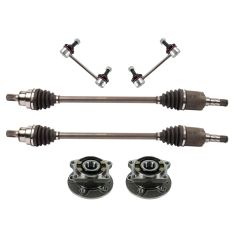1ASHS00239-Volvo XC90 Rear Driver & Passenger Side 2 Piece Wheel Bearing & Hub Assembly Set TRQ BHA53470

Replaces
2012 Volvo XC90 All Wheel Drive Rear Driver & Passenger Side 2 Piece Wheel Bearing & Hub Assembly Set TRQ BHA53470

Product Reviews
Loading reviews
4.88/ 5.0
8
8 reviews
Good Product!
January 25, 2017
Ordered these hubs because my Volvo was making a terrible noise. I knew it was the hubs and have had success with 1Aauto before. There were a lot of choices but I chose these for the cost and because they came in a pair. It immediately fixed the problem and still good after a thousand miles. Will definitely use 1Aauto again.
Hub assembly pair XC90
February 24, 2019
Parte were correct, and the fixed the concern..I liked that the hub assembly came with the correct torque specifications. Operating as designed. Also I have ordered parts before from 1A Auto. They have always come correct and work very well.
Fast delivery, perfect match
March 17, 2019
The parts arrived even faster than promised and were exactly what I needed. Great quality. Great price
Perfect
October 2, 2019
We drive a v8 xc90, so occasionally parts are not interchangable, but this fit perfectly. It fixed the minor whirling sound that goes with wheel bearings. It was fast to get to us and just what we needed. I do want to say, it does not come with replacement bolts, so you might want to make sure yours are in good shape before starting the install. I used a wire brush and cleaned our, so no big deal, but it is something to note.
Perfect fit
December 14, 2019
Priced well as a pair, they look to be well made. They should last a long time. Also the 1A videos are a great help. I did have to take the vehicle to a shop to get one side off as it was so badly rusted I had no choice. I have made purchases from 1A before and will in the future.
Thanks 1A!
The Right Parts for the Right Car
January 28, 2020
Never owned a Volvo before and enjoyed it, until my son mentioned the noise coming from the rear axle. And it seemed to be getting louder. Ordered the rear axle bearing hubs. They cam quick and we installed them ASAP. No more noise! The parts fit right the first time and did the job right out the gate. Thanks for getting it back up to snuff again. I am enjoying driving the car again. Bob Balise
So far So good!
May 24, 2021
I had no idea how loud my original bearing were. Replaced at 125k miles and the XC90 drives quieter than ever!!! Seems to be a very quality part!
XC90 2005 Rear Bearings
February 6, 2023
I installed these rear bearinidgs on 2005 Volvo with 211k miles. One of the old bearings was clearly bad, the second one was probably still good, but replaced both anyway. You need one of those tools that you hit with a hammer to remove them from the vehicle. Follow A1Auto video for complete instructions.
While the bearings are off, consider replacing rear brake pads and rotor.
To aid disassembly, put a little penetrating on the brake retainer clips where they enter the caliper. One of mine got stick from all the rust and it was very hard to get it apart.
Customer Q&A
Are the necessary bolts included?
July 12, 2016
10
They were not. But your old ones can be re-used
July 12, 2016
A N
10
No. Unbolt the current bolts on the vehicle, swap the hub/bearing parts and reuse the hardware. It should all work out nicely as it did for me. You can get replacement hardware at the local shop if one is bad/stripped/etc.
July 13, 2016
Robert S
10
no
July 14, 2016
Vicky L
10
No, You would reuse OEM hardware
July 18, 2016
Brian F
10
Nope.
October 2, 2019
Jacob M
10
No bolts included, you should be able to use the old bolts as I did so long as you don't round them off. Always start with a rust remover first, take the 10minutes and 5 extra bucks and spray them. If you do replace the bolts make sure to get auto grade not just any bolt from a hardware store.
December 14, 2019
J C
Do these work for the fwd version of the car?
May 31, 2022
10
This part will not fit your vehicle, but we may have a part that is listed to fit.
Please enter your vehicle's year make and model in the search bar at the top of the page. This will display parts guaranteed to fit your vehicle. Just be sure to verify all of the information shown in the Vehicle Fit tab before ordering.
June 1, 2022
Kelly S
Who is the manufacturer of the bearing in the hub?
April 21, 2024
10
These are manufactured by TRQ. TRQ is a high quality, high-end name brand that we offer and back with our 1A Auto Limited Lifetime Warranty.
April 22, 2024
Jean O
Volvo is a registered trademark of Volvo Trademark Holding AB. 1A Auto is not affiliated with or sponsored by Volvo or Volvo Trademark Holding AB.
See all trademarks.










